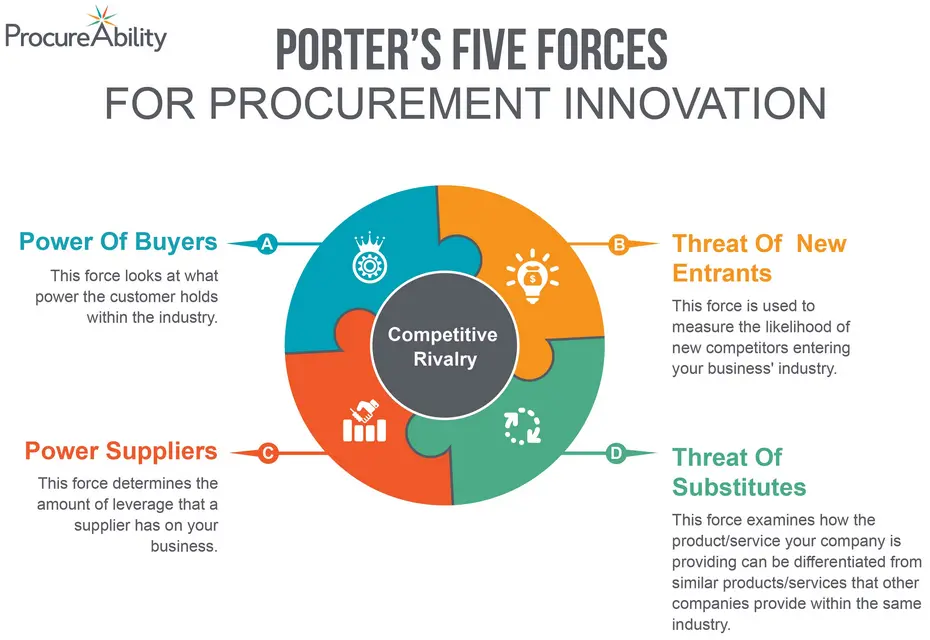
To succeed as a business, it is essential that you understand your industry’s strengths, weaknesses, and the competitive forces that exist within it. Porter’s Five Forces Analysis is a model developed to serve exactly this purpose and can apply to businesses at almost any scale. Through this innovative analysis, Porter helped to deliver a strategic reinvention of procurement that is currently utilized by the world’s most ground-breaking companies.
Utilizing the Five Forces Analysis allows a business to understand the levels of competition within their industry’s environment based on 5 different factors. With this knowledge, the company can then develop an optimized business strategy to drive higher profitability.
So, how do you put Porter’s 5 Forces into practice? In one recent example, we worked with a large utility client to incorporate Porter’s 5 Forces into their category planning process. We quickly helped them to assess the impact of each force and how it could impact their overall category plan and sourcing execution strategies. By using Porter as a guide, the client, coached by Arroyo Strategy’s category strategy experts, was able to develop a fact-based strategy that can be adjusted as market conditions change.

Competitive Rivalry:
Understanding the strength of your competition within an industry is an essential component to formulating a successful business strategy. Competitive rivalry is the most important factor in this analysis because it both impacts and is impacted by all the other forces.
Factors to consider in a sourcing event:
- How many competitors does your business have?
- How much of a market share do you hold against your competitors?
- Can you leverage your company’s position within your competitive environment to achieve higher profit margins?
Power of Buyers:
This force looks at what power the customer holds within the industry. The consumer market dictates the demand of your product or service, making it a significant factor of business profitability.
Power of buyer’s factors to consider in a sourcing event:
- How can buyer demand impact the prices of your product/service?
- How many buyers do you have? (The fewer customers your business has, the greater power buyers hold)
- What level of importance do different customers have to your business? (Some customers may be more valuable than others, and therefore hold more power)
Power of Suppliers:
This force determines the amount of leverage that a supplier has on your business. Suppliers are key determinants in your businesses operating cost, and ability to provide a product/service. Thus, this force can have a large impact on profitability.
Power of supplier’s factors to consider in a sourcing event:
- How essential is the supplier’s product/service to your business?
- Are there multiple suppliers that can provide the same product/service? (The fewer suppliers there are, the more power they have)
- Can you leverage the number of potential suppliers for concessions?
Threat of Substitutes:
The purpose of this force is to examine how the product/service your company is providing can be differentiated from similar products/services that other companies provide within the same industry. If there are numerous substitutes to what your business is delivering to customers, then you will have less power in your industry and face increased competition.
Threat of substitute’s factors to consider in a sourcing event:
- How is your company’s product/service unique?
- How does the quality of your product/service compare to substitutes?
- How does the price of your product/service compare to substitutes?
Threat of New Entrants:
This force is used to measure the likelihood of new competitors entering your business’ industry and can provide valuable insight when forecasting and developing a business strategy. As a company you should always protect yourself against new entrants to prevent losing market share.
Threat of new entrant’s factors to consider in a sourcing event:
- How quickly is the market your business operates in growing? (Markets that are quickly developing will result in increased competition)
- How much initial capital would a company need to enter your market?
- How strictly is your industry regulated? (Defense vs. furniture)
- What level of customer/brand loyalty exists in the in the industry?
Any company that seeks success will research and analyze their competition to come up with a strategy that best positions themselves within their industry. Porter’s Five Forces is a blueprint that allows a business to assess specific areas which have the largest impact on competition within a market. The use of Porter’s model within procurement can range from reducing costs to minimizing risk to driving innovation and because every business cycle begins with procurement, this makes it the best place to start.
For more on this topic, or to request a consultation on your procurement organization’s business strategies, reach out to one of our Procurement experts today!
Subscribe to Arroyo Strategy Insights to access whitepapers, presentations, plus our latest thought leadership.


